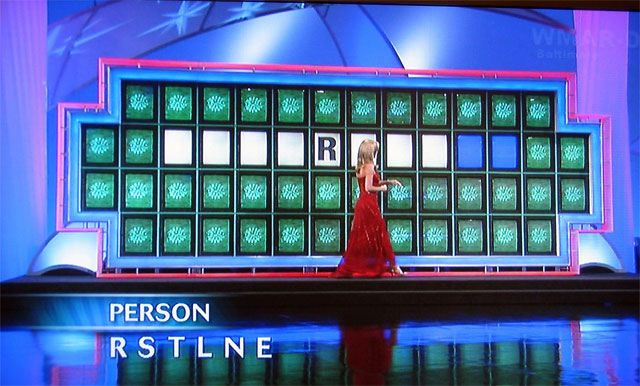Wheel of Fortune is the longest-running syndicated game show in American television history. One of the factors I attribute to its popularity is the relative simplicity of the game approach that enables audience members of all ages and intellectual prowess to participate. During the game three contestants compete with one another in efforts to solve a series of hangman-style word puzzles. Once a certain time threshold has been reached the leading contestant moves into a bonus round. During the bonus the contestant can win various cash prizes or a new car if he or she can correctly solve the final puzzle. For the first 13 years of the show, a format was used in which the contestant was allowed to pre-select five consonants and a vowel that he or she thought would be in the puzzle. The contestant was then given 15 seconds to guess the words in the puzzle with their pre-selected letters filled in. In 99% of the cases, contestants chose the same five consonants – RSTNL and the same vowel – E. Those letters were chosen because statistically they are more common in English words than any others. I often wondered why the show producers continued to allow the contestant to select the letters if the choices were always the same. The cynic in me suspected that the game show producers could easily manage the profitability of the show with such an approach. The game producers were aware of the high probability that contestants would select these letters. So if there was a prize that they did not want to really give away, they could select a phrase without those letters and be fairly confident that the contestant would lose. For example, if they wanted to offer a $100,000 boat as a bonus prize that they could not afford to give away, the show producers would simply pick a puzzle with only one of the RSTLNE letters and watch the contestant fail miserably.
After 15 years of the same pattern repeating, the show producers finally decided to change the process in 1988. Contestants would automatically be given RSTLN and E and then would have to make additional choices of three consonants and one vowel. By forcing the selection of a second tier of letters, contestants were forced to gamble more as the usage of letters is less consistent. This actually created a more dynamic environment in which odds of success could vary considerably.

If you have watched Wheel of Fortune you are probably well aware of everything I wrote above. So what does this have to do with B2B marketing? There is a similar pattern occurring in technology marketing in 2009. In fact, I could argue it has been occurring for over a decade. Vendors all use the latest technology buzzwords to describe their business model and product line. At least, one third of the average product brochure is comprised of buzzword-rich gobbledygook. Since every vendor uses the same buzzwords, the content is undifferentiated and relatively pointless. I think we should agree to adopt a rule in the technology marketing sector in 2009 called GG3SC. The GG3SC principle would be that unless otherwise stated, readers of technology marketing literature should assume that the vendor’s products are:
- Global – available all of the world – most likely in English with a US toll free support number
- Green – saving the planet by you electing to use them
- Software as a Service – available in the SaaS paradigm as well as traditional license models
- Social Networking – adopting all the techniques of FaceBook and MySpace
- Services Oriented Architecture – built using a highly flexible SOA approach
- Cloud Computing – offering network-based, dynamically scalable value added services
Using GG3SC, we could save a considerable amount of marketing effort. Efficiency in the collateral writing process would increase by 33% alone. This is not to mention all of the precious time end-customers would regain by not having to sift through undifferentiated positioning…










One Comment